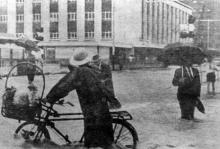17 May 1942, John Charter's wartime journal
Primary tabs
Yes, the hot weather has come and both today and yesterday the temperature must have reached the eighties. Fortunately there were quite a few electric refrigerators in these flats and with their help it is possible to keep the meat overnight and prevent it from going bad. I believe some of these ‘fridges have been distributed to other blocks in the camp.
The food has improved quite a lot, thank God. We still rise from our meals feeling we could eat more, but we don’t get up feeling hungrier at the end than at the beginning as we did a few weeks ago. I suppose the very act of eating makes the digestive juices begin to flow which increases appetite and really after those scanty meals, we felt just as hungry at the end as at the beginning.
We now get on average per day: 8 ozs rice, 7½ ozs flour, an average of 200 lbs of meat and bone for our blocks (750 people) which means we get about 2½ ozs (70 grams) of actual meat, and the bones, grissle and uneatable portions of the meat are boiled for meat stock. We are given a variety of vegetables: lettuce, spinach, egg plant (brinjals), cucumbers, marrows, occasionally tomatoes, sweet potatoes and carrots, and the amount varies - usually about 200 to 250 lbs per day or about 5 ozs (140 grams) per day per head. Sugar and salt is still about the same, about ½ oz per person per day.
The flour is an absolute godsend: a competent gang of workers, including Blackmore and Ogden (bricklayers), Wallis, Black, Hamilton, Robinson, Greenwood, (blacksmiths) and Howel, Fuller and Mackie (electricians), got together. Blackmore designed the oven and the others worked with him and built a really first class electric bakery oven in which can be baked 72 lbs of bread (in 12 pans with 6 lbs in each). Wallis started to make yeast from raisins, feeding it on flour, sugar and warm water. Mrs Wallis tended the growing yeast which had to be kept warm with hot water bottles (!) and fed every four hours. The net result of all this labour is that we each get ½ lb of bread per day, and the difference this makes to our general well being is quite phenomenal. It takes approx. 4 ozs of flour (or a little more) to make ½ lb of bread, so we still have about 3 ozs of flour per person left over each day and with this the kitchen staff makes Cornish pasties or sausage rolls or biscuits, generally for one meal in 3 days. The pastry is rather hard and leathery because the only shortening available is peanut oil, which (by the way) is supplied in small quantities with our other rations. These are cooked in the electric ovens of which there are about 5. To make and cook 750 Cornish pasties or 1500 biscuits is no small task when only 5 ovens are available.
The bakery oven is very useful for these pasties also. Three ovens were dismantled and the electric elements used for the bakery. This bakery oven has thermometers on the doors to register the heat of the oven (it reaches the requisite 400 degrees Farenheit quite easily) and even boasts a brass plate to say it was erected by the engineers of Blocks 2,3,4 and 5 of Stanley Prisoners of War Internment Camp, May 1942. It was built in a ground floor kitchen of block 3, of hollow concrete blocks, finished on top with Canton tiles (flat roofing tiles) and coated all over with asbestos lagging in which the hot water cylinders in the flats had been lagged. The doors were made of metal window frames (blown out by a shell) covered with sheet iron and filled in between with the lagging. The only criticism of the bread is that it is rather inclined to taste a little sour. This is because the bakers cannot procure proper yeast. But it tastes very good for all that.

